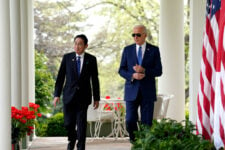Fumio Kishida, Japan’s prime minister, left, and US President Joe Biden, right, arrive for a news conference during a state visit in the Rose Garden of the White House in Washington, DC, US, on Wednesday, April 10, 2024. (Yuri Gripas/Abaca/Bloomberg via Getty Images)
WASHINGTON — The US and Japan today announced a series of defense-related moves that the two nations say will enhance their ability to counter aggression — be it from China, North Korea or some other source — in the Indo-Pacific region.
In a joint statement from the White House, US President Joe Biden and Japanese Prime Minister Fumio Kishida stated that to “advance our global partnership, today we announce several new strategic initiatives to strengthen our defense and security cooperation; reach new frontiers in space; drive technology innovation; bolster economic security; accelerate climate action; partner on global diplomacy and development; and fortify the ties between our peoples.”
As part of the agreement, the two nations agreed to create a Forum on Defense Industrial Cooperation, Acquisition and Sustainment (DICAS), which will identify priority areas where the two sides can work together.
Among the capabilities identified in the statement are the “co-development and co-production of missiles and co-sustainment of forward-deployed U.S. Navy ships and U.S. Air Force aircraft, including fourth generation fighters, at Japanese commercial facilities, in coordination with relevant ministries.”
In addition, the two sides pledged to create a working group on future pilot training and, interestingly, “co-development and co-production of cutting-edge technologies such as common jet trainers to maintain combat-ready next-generation fighter airpower.” Currently, Japan operates the domestically built T-4 trainer, while the US Air Force is planning to shift to the Boeing-Saab made T-7A. (The US Navy is in the early stages of procuring its own future training aircraft.)
In a fact sheet, the White House stated that US firm General Atomics will “provide” two MQ-9B SeaGuardian UAVs for Japan’s coast guard. General Atomics spokesman C. Mark Brinkley confirmed the two MQ-9s are a direct commercial sale to Japan, and are separate from the three aircraft currently on a contractor-owned, contractor-operated lease.
RELATED: Japan PM’s Washington trip: Bilateral focus but ‘groundbreaking’ trilateral goals
In an interview with Breaking Defense on Monday at the Sea Air Space Conference, Dave Alexander, president of General Atomics Aeronautic Systems, said ongoing tests with Japan were providing both the company and the Japanese military valuable information about how to operate the MQ-9B in the Indo Pacific.
While a trilateral agreement had already been announced between the US, Japan and Australia to help develop unmanned aerial systems, today’s announcement also notes the nations “are exploring cooperative opportunities in the rapidly emerging field of collaborative combat aircraft and autonomy.” CCAs are “loyal wingman” drones being developed as part of a future air force, with both the US Navy and Air Force currently in discussion with industry about options.
RELATED: US Air Force plans CCA downselect within ‘months,’ second increment in FY25: Kendall
Additionally the US and Japan “intend to work together toward our vision to cooperate on a networked air defense architecture, incorporating future capabilities with Australia.”
And on another trilateral front, Washington and Tokyo will be teaming with London on a regular exercise in the Pacific starting in 2025, the three sides announced.
“Conducting joint exercises sends a strong message to anyone who would seek to undermine the rules-based international order — our defense relationships are not limited by distance and we stand ready to respond to any threat around the globe,” said British defense secretary Grant Shapps in a statement. “A safe and stable Indo-Pacific is vital to our collective security, allowing free and unhindered trade and travel, and our world-leading partnerships with Japan and the US further emphasize our commitment to the region.”
While not the sexiest item to be announced today — the decision to make a Japanese astronaut the first non-American to step foot on the moon will likely raise eyebrows — the two sides also made an important step towards improving the technical integration of their militaries.
The two intend to “bilaterally upgrade our respective command and control frameworks to enable seamless integration of operations and capabilities and allow for greater interoperability and planning between U.S. and Japanese forces in peacetime and during contingencies,” per the White House statement. “More effective U.S.-Japan Alliance command and control will strengthen deterrence and promote a free and open Indo-Pacific in the face of pressing regional security challenges.”
“Together, our countries are taking significant steps to strengthen defense and security cooperation, we’re modernizing command and control structures, and we’re increasing the interoperability and planning of our militaries so they can work together in a seamless and effective way,” Biden said today.
No further detail was provided. However, Markus Garlauskas, a regional expert with the Atlantic Council, wrote in an analysis that the change in the command structure has to “address the Japanese C2 component, the future structure of US Forces Japan, how US and Japanese forces will operate together in and around Japan, and how these forces will operate with other countries’ forces and farther afield from Japan.”
Valerie Insinna contributed to this report.











